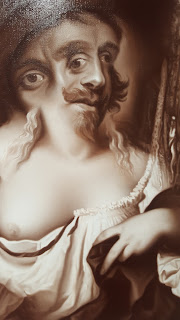I visited his Birth of Tragedies show at the Parafin (a neat little gallery just down from Bond Street tube that recently hosted a delightful little show by Justin Mortimer) not 100% sure quite what to expect after taking in a press release that alluded to 'different registers of reality' and 'an unsettling currency'.
I needn't have worried. I may not have fully understood why Martinec had chosen to name one of his works Brexit, nor why he'd chosen as his subject matter, in The Boat on the Moon, a floating baby scan, but I couldn't fail to be ever so slightly mesmerised by the way he'd worked his oil paints up into such a beautiful dissonance.
Chocolate Labyrinth and Tea (2016)
Brexit (2016)
He'd named the show The Birth of Tragedies in tribute to an 1872 text by Friedrich Nietzsche, The Birth of Tragedy, in which the 19c German philosopher argued for an immersive form of art that emphasised the passionate Dionysian over the rational Apollonian. I've never really seen passion and rationality as opposites and, in fact, would make the case that some of the most passionate acts ever have been based on, what at least would've seemed to be the case at the time, rational and logical reasoning.
Never mind, Nietzsche wasn't right about everything but he certainly made some interesting points so it's no surprise that he's inspired an artist born eight full decades after his death. Martinec was born in 1980 in the small Czech town of Broumov near the border with Poland so he is, both by birth and inclination, a bohemian.
For someone with a keen sense of art history there's a fun game of spot the reference to be had with his works. I'll freely admit that I couldn't find the promised nod to Zurbaran and had to be told that the satyr with the VR headset in Circus of Nightmares was a tip of the cap to Van Dyck.
Songs from the Last Century reminded me of the Gerhard Richter artwork that Sonic Youth appropriated for Daydream Nation twisted through the surreal genius of Salvador Dali and Peter Paul Rubens seemed to be the obvious progenitor of last year's The Shepherd Paris but why?
I think what Martinec is trying to do is get us, in these uncertain times (check the pluralisation of Tragedy in his show title), to question the very nature of history (art or otherwise) and the fluidity of truth. In the world of fake news, alternative facts, and barefaced bullshitting you're on shaky ground if you start saying there is more than one version of the truth but Martinec's argument is more nuanced than that. What he's saying with these works is that there's more than one way of seeing something - and that that can change over time depending on the viewer, where they are in their life at that moment, and what surrounds them.
Circus of Nightmares (2017)
Songs From The Last Century (2016)
The Boat on The Moon (2017)
Flogging Baroque Horse (2017)
The Shepherd Paris (2016)
Cross the Line (2016)
The well lit ground floor room contains most of Martinec's larger paintings but you can descend a small staircase into a darker basement room where can you witness an even more playful, cheeky, aspect of Martinec's work.
These drawings appropriate imagery from Old Masters and vintage photography and combine them with the signatures of internationally famous artists like Duchamp, Giacometti, Degas, Picasso, Klee, Beuys, and Schiele. The works and signatures don't match up ('Oscar Wilde' has signed one of them!) which, as well as cocking a snook, Duchamp style, at the art world, underlines Martinec's point about how our views of (art) history change over time.
Marcel Duchamp (2015)
Alberto Giacometti (2015)
Edgar Degas 1899 (2016)
Pablo Picasso (2015)
Martinec talks a good game, and he no doubt has serious things to say about how we see, what we see, and why we choose to see in such a way, and he's a great painter too. You can come and ponder matters of Nietzschean metaphysical voluntarism and the hegemonic nature of art historical narratives or you could just pop in and enjoy his rather beautiful, slightly disarming but aesthetically very pleasing, paintings. I like to think I did a bit of both.
Study of Baroque (2017)
















No comments:
Post a Comment